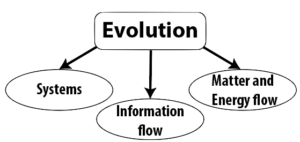By organizing the material in AP Biology around four Big Ideas, the College Board has made the task of teaching a thematic course much easier. Here’s my take on these ideas, which I’ll be using as core themes that I’ll revisit again and again throughout the coming year.Though I’m presenting these ideas in outline form, there is a conceptual hierarchy. I’m a believer in Dobzhansky’s quote that “Nothing in biology makes sense except in the light of evolution.” If you were to map the ideas below, they’d come out like this:

So, for example, when we talk about biological systems, we have to keep in mind that these are systems that evolved over time through natural selection. Moreover, these systems evolved as genetic information was sent to the future through the process of reproduction. Only those offspring with an array of genetic information that resulted in survival were able to reach adulthood and repeat the process of passing their genes forward into the future. That genetic information, in every case, involved instructions for converting matter and energy in the environment into another version of that organism. Life, in other words, is about organic information systems (populations of organisms) that evolve by using genetic information about how to use matter and energy in order to build more of the same types of systems.
Here’s each theme, slightly fleshed out.
- Evolution
- Life has a history, consisting of events that unfolded in a contingent way. The features of living things can only be understood in relationship to life’s history.
- Because of evolution, the pattern of life shows both unity and diversity.
- Living things, unlike non-living things like planets or mountains, have adaptations: structures that perform functions.
- Adaptations are not only structural: they’re also behavioral. Living systems, as Richard Dawkins would say, are programmed survival machines, carrying out behaviors that promote survival and reproduction.
- The process of natural selection explains how adaptations arise.
- Systems
- Living things are complex systems with boundaries, inputs, processes, and outputs.
- Living things are composed of interacting subsystems, and are embedded within larger systems.
- Information flow
- Living things can pass on their genes – instructions for recreating themselves – to their offspring.
- Living things receive information, analyze it, and respond to it by transmitting information throughout their bodies and to other organisms.
- Matter and Energy Flow
- Living systems, during the course of their lives, can stave off entropy by channeling energy flow, enabling them to maintain high levels of order.
- Matter flows through all living systems.
My plan is to have my students constantly work at applying these themes. Here’s a first attempt at a series of questions that they can draw from as they read chapters, respond to lectures, watch videos, analyze labs, walk in the woods, prepare breakfast, clean up after their dogs, plant seeds, eat apples, and, in general, do the things that humans do. Note as you read that I’ve generally used “chapter” in the prompt, but it could be anything.
- Evolution:
- What parts of this chapter touched on the idea of evolution?
- How did what you learn relate to the unity and diversity of life?
- Where in this reading were there examples of structure/function relationships?
- Where did you see examples of survival and reproduction strategies?
- If this reading focused on a specific adaptation, how does that adaptation work? How do you think that it evolved?
- Life is full of weird, quirky features that can only be explained by the fact that life was not engineered, but that it evolved over time. If there was evidence of features that can only be explained as a result of life’s contingent, quirky, historical nature, describe it.
- Systems
- What systems did you encounter? What were these systems’ boundaries, inputs, processes, and outputs?
- What were the subsystems of the systems you learned about? How did this subsystems interact? What relevant larger systems was this system embedded within?
- Information flow
- What in this chapter related to the idea that living things pass on their genes – instructions for recreating themselves – to their offspring?
- What related to the idea that living things receive information; analyze it, and respond to it?
- Matter and Energy Flow
- Where did you see information about how living systems maintain high levels of order by channeling energy flow?
- Where did you see discussion about how matter flows through all living systems?
I’d love to know what you think about these themes. If you’ve got feedback, warm or cold, let me know!
